Acer orporated MPCI-101 User Manual TM620 e
Acer Incorporated TM620 e
Contents
for Notebook part 2

23
a page up, down, left or right. This button mimics your cursor
pressing on the vertical and horizontal scroll bars of Windows
applications.
Note: Keep your fingers dry and clean when using the touchpad.
Also keep the touchpad dry and clean. The touchpad is sensitive
to finger movements. Hence, the lighter the touch, the better the
response. Tapping harder will not increase the touchpad’s
responsiveness.
Function Left button Right
button
Center
buttons Tap
Execute Click twice
quickly
Tap twice (at the
same speed as
double-clicking a
mouse button)
Select Click once Tap once
Drag Click and
hold, then
use finger to
drag the
cursor on the
touchpad
Tap twice (at the
same speed as
double-clicking a
mouse button)
then hold finger
to the touchpad
on the second tap
and drag the
cursor
Access
context
menu
Click
once
Scroll Click and
hold the
button in
the desired
direction
(up/down/
left/right)
TM620-e.book Page 23 Tuesday, October 16, 2001 11:22 AM

Getting to know your TravelMate24
Storage
This computer supplies you with the following media storage:
•High-capacity Enhanced-IDE hard disk
•AcerMedia drive
Hard disk
The high-capacity hard disk is the answer to your storage needs. This is
where your programs and data are stored.
AcerMedia drive
The AcerMedia bay accepts a wide variety of optional media drive
modules for use with your computer. These optional items include:
•CD-ROM drive
•DVD-ROM drive
•DVD/CD-RW drive
•Second hard disk drive
•Floppy disk drive
Note: To swap AcerMedia drive modules, see “Swapping
AcerMedia drive modules” on page 52
TM620-e.book Page 24 Tuesday, October 16, 2001 11:22 AM
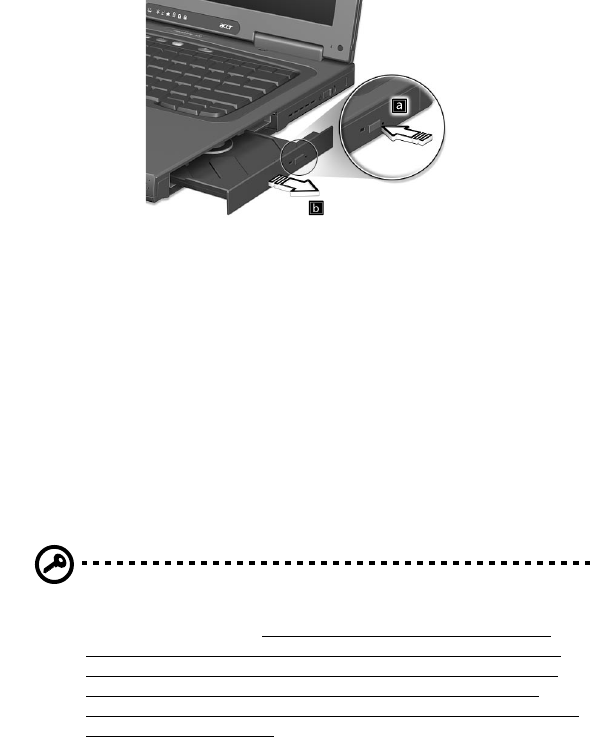
25
Ejecting the optical (CD or DVD) drive tray
To eject the optical drive tray when the computer is turned on, press
the drive eject button.
When the power is off, you can eject the drive tray using the
emergency eject hole. See page 60.
Using software
Playing DVD movies
When the DVD-ROM drive module is installed in the AcerMedia bay,
you can play DVD movies on your computer.
1 Eject the DVD tray and insert a DVD movie disc; then close the DVD
tray.
Important! When you launch the DVD player for the first time,
the program asks you to input the region code. DVD discs are
divided into 6 regions. Once your DVD drive is set to a region
code, it will play DVD discs of that region only. You can set the
region code a maximum of five times (including the first time),
after which the last region code set will remain permanent.
Recovering your hard disk does not reset the number of times the
region code has been set. Refer to the table below for DVD movie
region code information.
TM620-e.book Page 25 Tuesday, October 16, 2001 11:22 AM
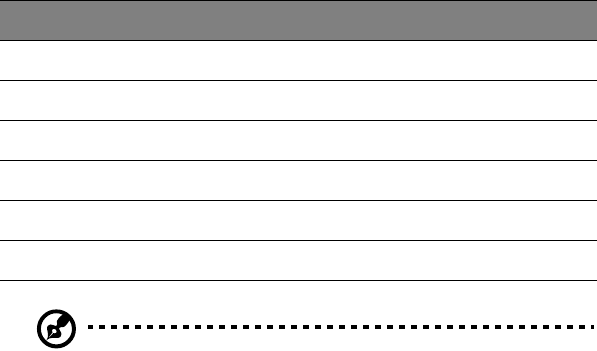
Getting to know your TravelMate26
2 The DVD movie will automatically play after a few seconds.
Note: To change the region code, insert a DVD movie of a
different region into the DVD-ROM drive. Please refer to the
online help for more information.
Region code Country or region
1 U.S.A., Canada
2 Europe, Middle East, South Africa, Japan
3 Southeast Asia, Taiwan, Korea (South)
4 Latin America, Australia, New Zealand
5 Former U.S.S.R., parts of Africa, India
6 People's Republic of China
TM620-e.book Page 26 Tuesday, October 16, 2001 11:22 AM
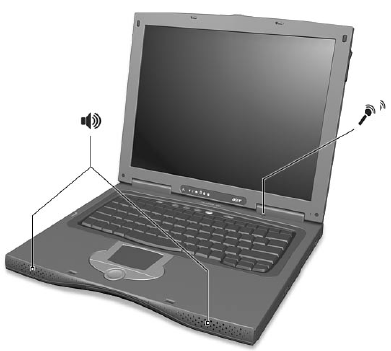
27
Audio
The computer comes with 16-bit high-fidelity AC’97 stereo audio, and
includes a built-in sensitive microphone and dual stereo speakers.
There are audio ports on the rear of the computer. See “Rear view” on
page 6 for more information on connecting external audio devices.
Adjusting the volume
Adjusting the volume on the computer is as easy as pressing some
buttons. See “Hot keys” on page 16 for more informations on
adjusting the speaker volume.
TM620-e.book Page 27 Tuesday, October 16, 2001 11:22 AM
Getting to know your TravelMate28
Power management
This computer has a built-in power management unit that monitors
system activity. System activity refers to any activity involving one or
more of the following devices: keyboard, mouse, floppy drive, hard
disk, peripherals connected to the serial and parallel ports, and video
memory. If no activity is detected for a period of time (called an
inactivity timeout), the computer stops some or all of these devices in
order to conserve energy.
This computer employs a power management scheme that supports
ACPI (Advanced Configuration and Power Interface), which allows for
maximum power conservation and maximum performance at the same
time. Windows handles all power-saving chores for your computer.
Refer to your online guide for more information.
TM620-e.book Page 28 Tuesday, October 16, 2001 11:22 AM
29
Moving around with your TravelMate
This section gives you tips and hints to consider when moving around
or traveling with your computer.
Disconnecting from the desktop
Follow these steps to disconnect your computer from external
accessories:
1 Save your work in progress.
2 Remove any media, diskette or compact disc, from the drive(s).
3 Shut down the computer.
4 Close the display cover.
5 Disconnect the cord from the AC adapter.
6 Disconnect the keyboard, pointing device, printer, external
monitor, and other external devices.
7 Disconnect the Kensington lock if you are using one to secure the
computer.
Moving around
“when you are just moving within short distances, for example, from
your office desk to a meeting room”
Preparing the computer
Before moving the computer, close and latch the display cover to place
it in Sleep mode. You can now safely take the computer anywhere you
go within the building. To bring the computer out of Sleep mode,
open the display.
If you are taking the computer to a client's office or a different
building, you may choose to shut down the computer:
1 Click on Start, Shut Down... or Turn off Computer (Windows
XP).
2 Select Shut down and click on OK, or select Turn Off (Windows
XP).
TM620-e.book Page 29 Tuesday, October 16, 2001 11:22 AM
Getting to know your TravelMate30
- or -
you can put the computer in Sleep mode by pressing Fn-F4. Then close
and latch the display.
When you are ready to use the computer again, unlatch and open the
display, and press any key. If the power indicator is off, the computer
has entered Hibernation mode and turned off. Slide and release the
power switch to turn the computer back on. Note that the computer
may enter Hibernation mode after a period of time it is in Sleep mode.
Turn the power on to wake up the computer from Hibernation mode.
What to bring to short meetings
A fully charged battery runs the computer for about 4 hours under
most circumstances. If your meeting is shorter than that, you probably
do not need to bring anything with you other than the computer.
What to bring to long meetings
If your meeting will last longer than 4 hours or if your battery is not
fully charged, you may want to bring the AC adapter with you to plug
in your computer in the meeting room.
If the meeting room does not have an electrical outlet, reduce the
drain on the battery by putting the computer in Sleep mode. Press Fn-
F4 or close the display cover whenever you are not actively using the
computer. Then tap any key or open the display to resume.
Taking the computer home
“when you are moving from your office to your home or vice versa”
Preparing the computer
After disconnecting the computer from your desktop, follow these
steps to prepare the computer for the trip home:
•Check if you have removed all media, diskettes and compact discs,
from the drive(s). Failure to remove the media can damage the
drive head.
•Pack the computer in a protective case that can prevent the
computer from sliding around and cushion it if it should fall.
TM620-e.book Page 30 Tuesday, October 16, 2001 11:22 AM

31
Caution: Avoid packing items next to the top cover of the
computer. Pressure against the top cover can damage the screen
What to bring with you
Unless you already have some items at home, bring the following items
with you:
•AC adapter and power cord
•The printed user’s guide
•AcerMedia drive module(s)
Special considerations
Follow these guidelines to protect your computer while traveling to
and from work:
•Minimize the effect of temperature changes by keeping the
computer with you.
•If you need to stop for an extended period of time and cannot
bring the computer with you, leave the computer in the trunk of
the car to avoid exposing the computer to excessive heat.
•Changes in temperature and humidity can cause condensation.
Allow the computer to return to room temperature, and inspect
the screen for condensation before turning on the computer. If
the temperature change is greater than 18°F (10°C), allow the
computer to come to room temperature slowly. If possible, leave
the computer for 30 minutes in an environment with a
temperature between outside and room temperature.
Setting up a home office
If you frequently work on your computer at home, you may want to
purchase a second AC adapter for use at home. With a second AC
adapter, you can avoid transporting the extra weight to and from
home.
If you use your computer at home for significant periods of time, you
might also want to add an external keyboard, monitor, or mouse.
TM620-e.book Page 31 Tuesday, October 16, 2001 11:22 AM
Getting to know your TravelMate32
Traveling with the computer
“when you are moving within a larger distance, for instance, from your
office building to a client’s office building or traveling locally”
Preparing the computer
Prepare the computer as if you were taking it home. Make sure that
the battery in the computer is charged. Airport security may require
you to turn on your computer when bringing it into the gate area.
What to bring with you
Bring the following items with you:
•AC adapter
•Spare, fully-charged battery pack(s)
•AcerMedia drive module(s)
•Additional printer driver files if you plan to use another printer
Special considerations
In addition to the guidelines for taking the computer home, follow
these guidelines to protect your computer while traveling:
•Always take the computer as carry-on luggage.
•If possible, have the computer inspected by hand. Airport security
X-ray machines are safe, but do not put the computer through a
metal detector.
•Avoid exposing floppy disks to hand-held metal detectors.
Traveling internationally with the computer
“when you are moving from country to country”
Preparing the computer
Prepare the computer as you would normally prepare it for traveling.
TM620-e.book Page 32 Tuesday, October 16, 2001 11:22 AM
33
What to bring with you
Bring the following items with you:
•AC adapter
•Power cords that are appropriate for the country to which you are
traveling
•Spare, fully-charged battery packs
•AcerMedia drive module(s)
•Additional printer driver files if you plan to use another printer
•Proof of purchase, in case you need to show it to customs officials
•International Traveler’s Warranty passport
Special considerations
Follow the same special considerations as when traveling with the
computer. In addition, these tips are useful when traveling
internationally:
•When traveling in another country, check that the local AC voltage
and the AC adapter power cord specifications are compatible. If
not, purchase a power cord that is compatible with the local AC
voltage. Do not use converter kits sold for appliances to power
the computer.
•If you are using the modem, check if the modem and connector is
compatible with the telecommunications system of the country
you are traveling in.
TM620-e.book Page 33 Tuesday, October 16, 2001 11:22 AM
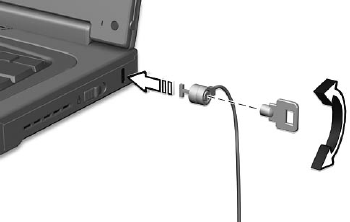
Getting to know your TravelMate34
Securing your computer
Your computer is a valuable investment that you need to take care of.
Learn how to protect and take care of your computer.
Security features include hardware and software locks — a security
notch, Smart Card and passwords.
Using a computer security lock
A security keylock notch located on the left panel of the computer lets
you connect a Kensington-compatible computer security lock.
Wrap a computer security lock cable around an immovable object such
as a table or locked drawer handle. Insert the lock into the notch and
turn the key to secure the lock. Some keyless models are also available.
Using the Smart Card
This software includes the following components: PlatinumPAS™,
PlatinumSecure™ and PlatinumKey™. Together, they provide you with
multiple levels of security.
• PlatinumPAS implements the first security measure at the BIOS
level and runs during the BIOS routine check when a computer is
powered up or rebooting. If no Smart Card or Emergency Card is
detected, the computer will stop booting up to prevent any illegal
access to the system.
• PlatinumSecure enhances the secure logon procedure for your
Windows at the operating system level. It provides user
authentication through its encryption/decryption function using
TM620-e.book Page 34 Tuesday, October 16, 2001 11:22 AM
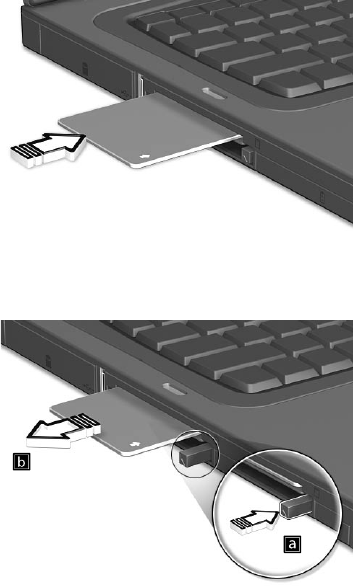
35
the Smart Card. If your Smart Card is unavailable, you can use the
Emergency Card as a temporary replacement card.
• PlatinumKey auto-authenticate and auto cache with one-click
logons to all password-required websites (patent pending),
eliminates the overhead costs associated with memorizing and
typing user IDs and passwords when surfing the Internet with
Microsoft or Netscape web browsers.
A slot for your Smart Card is located on the left panel of the computer.
This new security feature helps you boot up your computer with all
your settings built right into your Smart Card. You don’t have to
remember your password to access your computer.
To remove the Smart Card press the Smart Card eject button (a) and
remove the Smart Card (b) as shown in the illustration below.
For more details consult your Smart Card documentation.
TM620-e.book Page 35 Tuesday, October 16, 2001 11:22 AM

Getting to know your TravelMate36
Registering your Smart Card
Important! Your Acer notebook is equipped with a Smart Card
security feature that protects the computer from unauthorized
access. If you enable this feature, please make sure that your
warranty card is completed and sent back to Acer. This
information will be used by Acer service centers to confirm
ownership in case your Smart Card "key" is lost or damaged.
Registering your notebook with Acer's service center is extremely
important when replacing your lost Smart Card "key".
If you have already bypassed the Smart Card registration, please
reinstall the application as follows:
1 Insert your System CD and reinstall from it.
2 Follow the onscreen instructions.
To enable the Smart Card security feature, please refer to your Smart
Card user manual.
Running PlatinumSecure
PlatinumSecure enhances the secure logon procedure for Windows
Me, 2000 or XP at the operating system level. It provides user
authentication with an encryption/decryption function using the Smart
Card. If your Smart Card is unavailable, the Emergency Card can serve
as a temporary replacement for the Smart Card. After installation, the
PlatinumSecure icon appears on the Windows desktop. Double-click on
it or click the right mouse button, then select Open from the pop-up
menu (or launch it from the PlatinumSecret program group). From the
TM620-e.book Page 36 Tuesday, October 16, 2001 11:22 AM
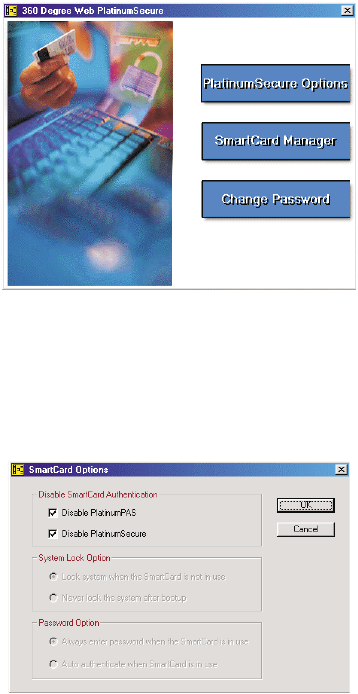
37
menu that appears, you can directly access three operations:
PlatinumSecure Options, Smart Card Manager, and Change Password.
PlatinumSecure Options
Click on the PlatinumSecure Options button to open the Smart Card
Options window. It provides great flexibility to meet the various
privacy protection needs of many different users.
• Disable Smart Card Authentication
When Disable PlatinumPAS is selected, the PlatinumPAS Preboot
Authentication System will be disabled.
When Disable PlatinumSecure is selected, the PlatinumSecure
Windows Logon Authentication with the Smart Card will be
disabled, which means that the protection of your PC as well as
other options under System Lock Option and Password Option
TM620-e.book Page 37 Tuesday, October 16, 2001 11:22 AM
Getting to know your TravelMate38
will be disabled, too. The Smart Card password is required for this
selection.
• System Lock Option
When Lock system when the Smart Card is not in use
(default) is selected, if the Smart Card is removed, the
PlatinumSecure screensaver comes up and access to the system is
locked. When Never lock the system after bootup is selected,
there is no protection for the PC after boot up, and Password
Option is disabled.
• Password Option
When Always enter password when the Smart Card is in use
(default) is selected, the password is required whenever you need
to regain access to the system while the Smart Card is inserted.
When Auto authenticate when Smart Card is in use is
selected, no password is required. All you need to do is insert the
Smart Card.
Smart Card Manager
The Multiple user support is implemented and managed in Smart Card
Manager. Please note that five users can be registered on one PC. If
you registered as the Primary User, ONLY you can add/remove other
users. If you registered as a regular user, other registered users could
add/remove you. All registered users will be able to use the View Smart
Card users option.
Change Password
Click the Change Password button, fill in the three fields in the
Change Password dialog box, and then close the dialog box by clicking
the OK button to change the Smart Card password.
Encrypt/Decrypt
PlatinumSecure can also be used to encrypt/decrypt files except for
system files or files that are already encrypted with other applications.
Double-click on a file to automatically encrypt/decrypt it. However, if
the file is associated with an application, it will be opened with that
application instead of being encrypted. Note that the encryption is not
recursive, i.e., when you encrypt a folder, only the files immediately
under that folder are encrypted. Other files under subfolders are not.
To find the Encrypt/Decrypt commands:
TM620-e.book Page 38 Tuesday, October 16, 2001 11:22 AM
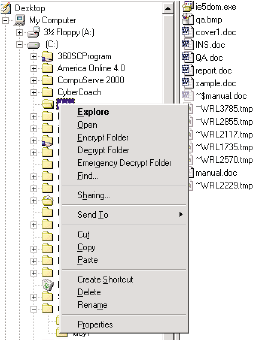
39
•Right-click on the Start menu,
•Right-click on a folder or icon on your Windows desktop, or
•In Windows Explorer, right-click on a selected folder, file, or group
of files.
Running PlatinumKey
PlatinumKey provides one-click logon to all password-required
websites. With its unique Smart Card caching technology, you can
greatly extend the limited card memory size to unlimited use by
storing your private data in an encrypted file either on the Smart Card,
or on the 360 Degree Web secure website server.
Information in PlatinumKey like the one in My Info and Credit Cards,
can be transferred to other applications using the "drag-and-drop"
method: simply point the cursor to the field containing the
information, press and hold the left mouse button, then drag the
cursor to the application and drop the information there.
PlatinumKey also makes it convenient to change your password. There
is always a PWD button available, which is equivalent to the Change
Password button in PlatinumSecure.
Follow these steps to use PlatinumKey:
1 Open your browser to connect to the Internet.
TM620-e.book Page 39 Tuesday, October 16, 2001 11:22 AM
Getting to know your TravelMate40
2 Double-click on the PlatinumKey icon on your Windows desktop.
3 Enter your Smart Card password and click OK.
4 If PlatinumKey is being used for the very first time, it will ask
"Would you like to link to 360 Degree Web secure website server
to backup the information on your Smart Card?" The default
answer is Yes, and it will enable you to store your information
(excluding the Credit Cards) on the 360 Degree Web secure
website server for backup purposes in case the card is lost/stolen. If
you choose No, you will only be able to save My Info, Credit Cards
and 5 Websites on your Smart Card.
5 Log in to a website where you are already registered.
6 PlatinumKey automatically stores your login data and asks for your
confirmation to automatically log you in the next time you access
the site. Click Yes and continue browsing.
7 To close PlatinumKey when you are finished browsing, right-click
on the PlatinumKey icon on your Windows taskbar and select
Close PlatinumKey.
PlatinumKey provides a list of all the logon pages that you have stored.
To go directly to any site on the list either double-click it or select it
and click the Go button. Also, you can click the View button to view
the selected website information including Web Name, User Name,
Password, and Web URL. Similarly, type the first letter(s) of a site on
the list, and the site will be searched and selected.
You can Edit and Delete the sites as well as other information, and
Save or Cancel the changes you made, by selecting the button
corresponding to each command.
Using passwords
Passwords protect your computer from unauthorized access. Setting
these passwords creates several different levels of protection for your
computer and data:
•Setup Password prevents unauthorized entry to the BIOS Utility.
Once set, you must key-in this password to gain access to the BIOS
Utility. See “BIOS Utility” on page 55 and your online guide for
more details.
•Power-on Password secures your computer against unauthorized
use. Combine the use of this password with password checkpoints
on boot-up and resume from hibernation for maximum security.
TM620-e.book Page 40 Tuesday, October 16, 2001 11:22 AM
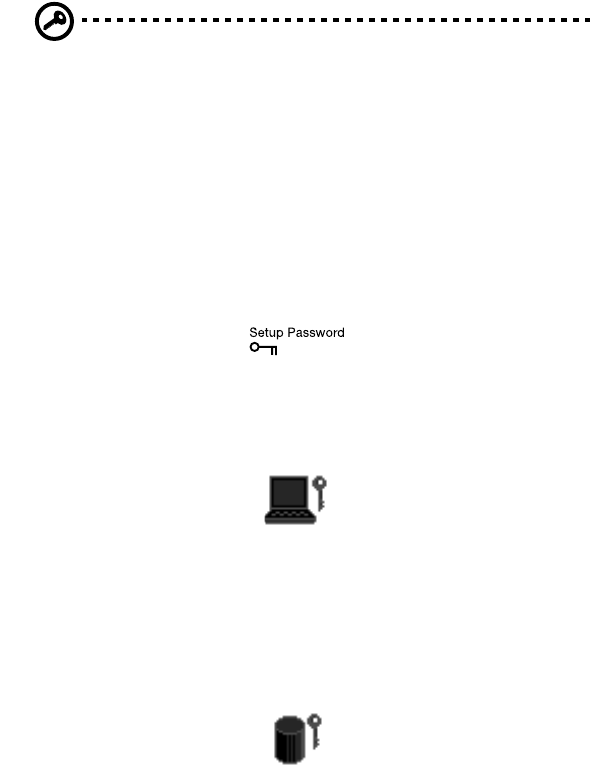
41
•Hard Disk Password protects your data by preventing
unauthorized access to your hard disk. Even if the hard disk is
removed from the computer and moved to another computer, it
cannot be accessed without the Hard Disk Password.
Important! Do not forget your Setup and Hard Disk Password! If
you forget your password, please get in touch with your dealer or
an authorized service center.
•Other passwords include Windows and screensaver passwords.
Entering passwords
When a password is set, a password prompt appears in the left-hand
corner of the display screen.
•When the Setup Password is set, the following prompt appears
when you press F2 to enter the BIOS Utility at boot-up.
Type the Setup Password and press Enter to access the BIOS Utility.
•When the Power-on Password is set, the following prompt appears
at boot-up.
Type the Power-on Password (a . symbol appears for each
character you type) and press Enter to use the computer. If you
enter the password incorrectly, an x symbol appears. Try again
and press Enter.
•When the Hard Disk Password is set, the following prompt appears
at boot-up.
Type the Hard Disk Password (a . symbol appears for each
character you type) and press Enter to use the computer. If you
enter the password incorrectly, an x symbol appears. Try again
and press Enter.
TM620-e.book Page 41 Tuesday, October 16, 2001 11:22 AM
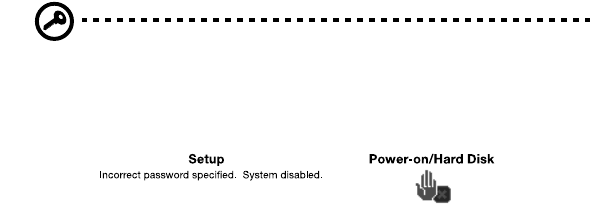
Getting to know your TravelMate42
Important! You have three chances to enter a password. If you
successfully entered the password, you are presented with a
correct entry symbol.
If you fail to enter the password correctly after three tries, the
following message or symbol appears.
Slide and hold the power switch for four seconds to shut down the
computer. Then turn on the computer again, and try again. If you
fail to enter the Hard Disk Password, please contact your dealer or
an authorized service center.
Setting passwords
You can set passwords using:
•Notebook Manager
•BIOS Utility
See your online guide for more details.
TM620-e.book Page 42 Tuesday, October 16, 2001 11:22 AM

2 Customizing my
computer
TM620-e.book Page 43 Tuesday, October 16, 2001 11:22 AM

After learning the basics of your TravelMate
computer, let’s get acquainted with the
advanced features of your computer. In this
chapter, you will learn how to add options,
upgrade components for better performance,
and customize your computer.
key link: accessories.acer.com
TM620-e.book Page 44 Tuesday, October 16, 2001 11:22 AM
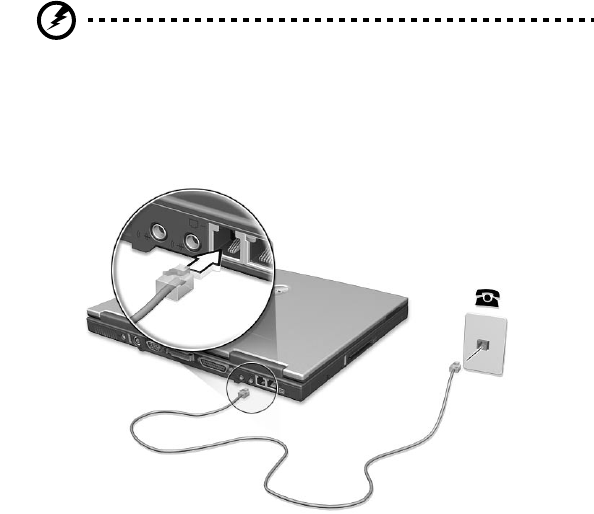
45
Expanding through options
Your TravelMate offers you a complete mobile computing experience.
Connectivity options
Ports allow you to connect peripheral devices to your computer as you
would with a desktop PC. For instructions on how to connect different
external devices to the computer, see your online guide for more
details.
Fax/data modem
Your computer have a built-in V.90 56Kbps AC’97 Link fax/data
modem.
Warning! This modem port is not compatible with digital
phone lines. Plugging this modem into a digital phone line
will damage the modem.
To use the fax/data modem port, connect a phone cable from the
modem port to a telephone jack.
Start your communications software program. See your
communications manual for instructions.
TM620-e.book Page 45 Tuesday, October 16, 2001 11:22 AM
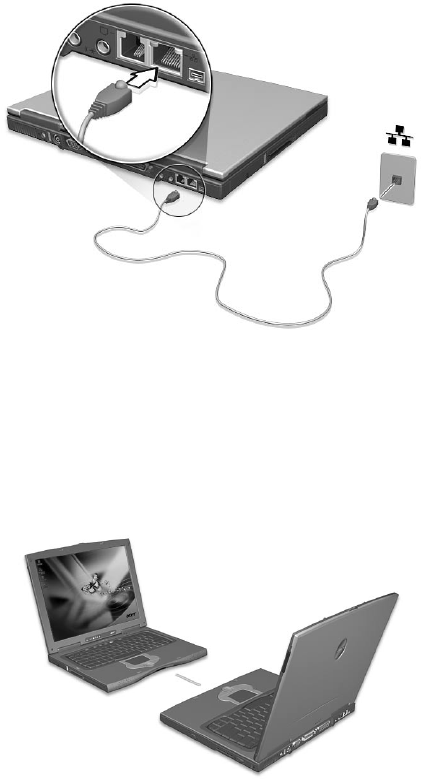
2 Customizing my computer46
Built-in network feature
The built-in network feature allows you to connect your computer to
an Ethernet-based (10/100 Mbps) network.
To use the network feature, connect an Ethernet cable from the
network jack on the rear of the computer to a network jack or hub on
your network.
Fast infrared
The computer’s fast infrared (FIR) port allows you to do wireless data
transfer with other IR-aware computers and peripherals such as PDAs
(personal digital assistants), mobile phones, and infrared printers. The
infrared port can transfer data at speeds of up to four megabits per
second (Mbps) at a distance of up to one meter.
TM620-e.book Page 46 Tuesday, October 16, 2001 11:22 AM
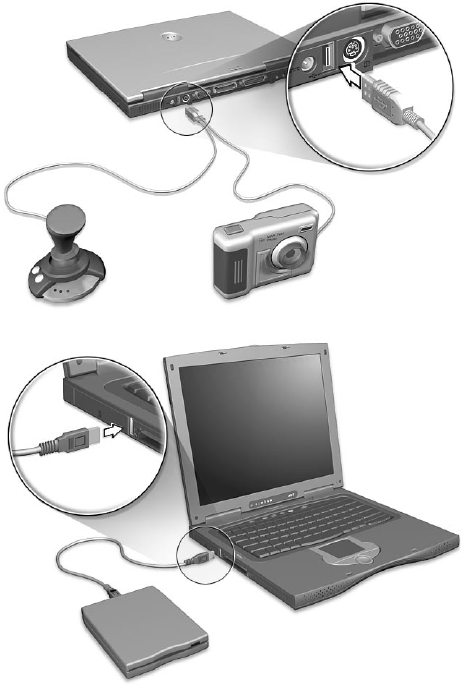
47
Universal Serial Bus
The Universal Serial Bus (USB) port is a high-speed serial bus which
allows you to connect and daisy-chain USB peripherals without taking
up precious system resources. Your computer has two ports available.
TM620-e.book Page 47 Tuesday, October 16, 2001 11:22 AM
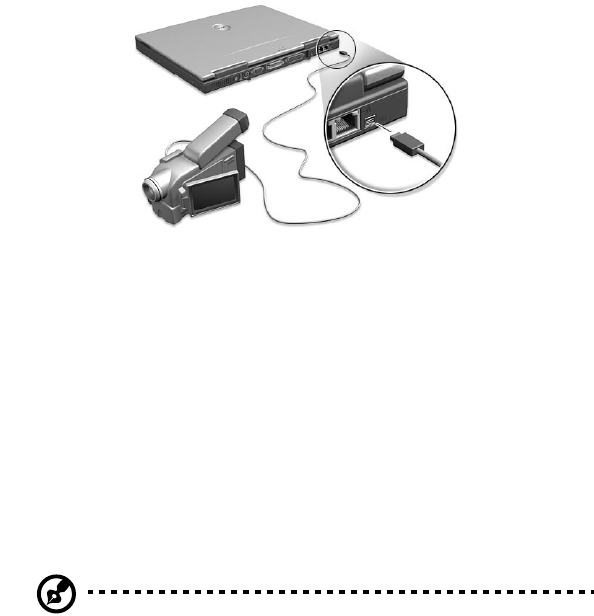
2 Customizing my computer48
IEEE 1394 port
The computer's IEEE 1394 port allows you to connect to an IEEE 1394
supported devices like a video camera or digital camera.
See your video or digital camera's documentation for details.
PC Card slot
The type II CardBus PC Card slot found on the left side of the computer
accepts credit-card-sized cards that enhance the usability and
expandability of the computer. These cards should have a PC Card
logo on them.
PC Cards (formerly PCMCIA) are add-on cards for portable computers,
giving you expansion possibilities long afforded by desktop PCs.
Popular type III cards include flash memory, SRAM, fax/data modem,
LAN and SCSI cards. CardBus improves on the 16-bit PC card
technology by expanding the bandwidth to 32 bits.
Note: Refer to your card’s manual for details on how to install and
use the card and its functions.
TM620-e.book Page 48 Tuesday, October 16, 2001 11:22 AM
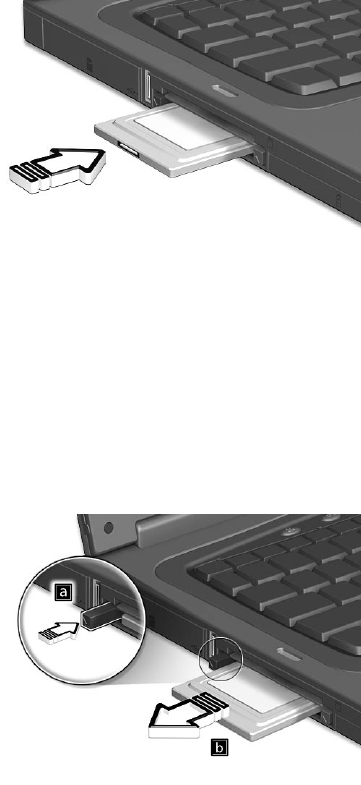
49
Inserting a PC Card
Insert the card into the lower slot and make the proper connections
(e.g., network cable), if necessary. See your card manual for details.
Ejecting a PC Card
Before ejecting a PC Card:
1 Exit the application using the card.
2 Left-click on the PC Card icon on the taskbar and stop the card
operation.
3 Press the slot eject button to pop out the eject button (a); then
press it again to eject the card (b).
TM620-e.book Page 49 Tuesday, October 16, 2001 11:22 AM

2 Customizing my computer50
Port expansion devices
Two types of expansion devices are available for your computer:
•I/O replicator - adds serial port and parallel port connections to
your computer.
•EasyPort - adds a host of ports for your computer, and allows you
to connect and disconnect peripherals from your computer in one
quick step.
See your dealer for more information.
Upgrade options
Your computer delivers superior power and performance. However,
some users and the applications they use may demand more. This
computer allows you to upgrade key components when you need
increased performance.
Note: Contact your authorized dealer if you decide to perform a
key component upgrade.
Memory upgrade
Memory is expandable to 1 GB, employing 128/256/512-MB industry
standard soDIMMs (Small Outline Dual Inline Memory Modules). The
computer supports SDRAM (Synchronous Dynamic Random Access
Memory).
There are two memory slots on your computer, one of which is
occupied by standard memory. You can upgrade memory by installing
a memory module into the available slot, or replacing the standard
memory with a higher-capacity memory module.
Installing memory
Follow these steps to install memory:
1 Turn off the computer, unplug the AC adapter (if connected) and
remove the battery pack. Then turn the computer over to access
its base.
TM620-e.book Page 50 Tuesday, October 16, 2001 11:22 AM
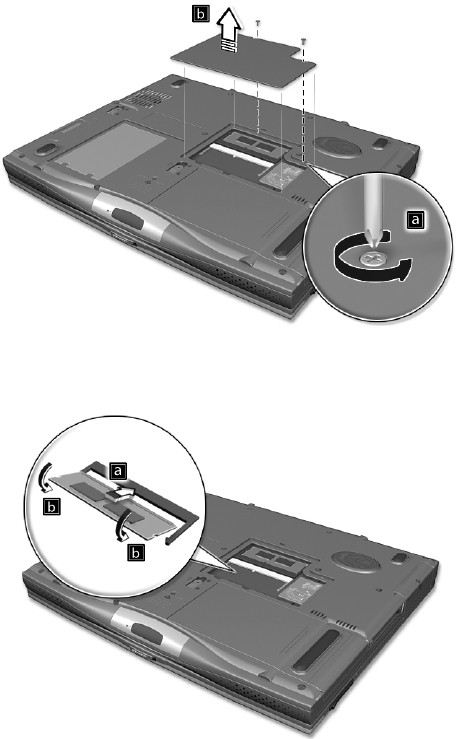
51
2 Remove the screws from the memory cover (a); then lift up and
remove the memory cover (b).
3 Insert the memory module diagonally into the slot (a), then gently
press it down (b) until it clicks into place.
4 Replace the memory cover and secure it with the screw.
5 Reinstall the battery pack, and reconnect the AC adapter.
6 Turn on the computer.
The computer automatically detects and reconfigures the total
memory size.
TM620-e.book Page 51 Tuesday, October 16, 2001 11:22 AM
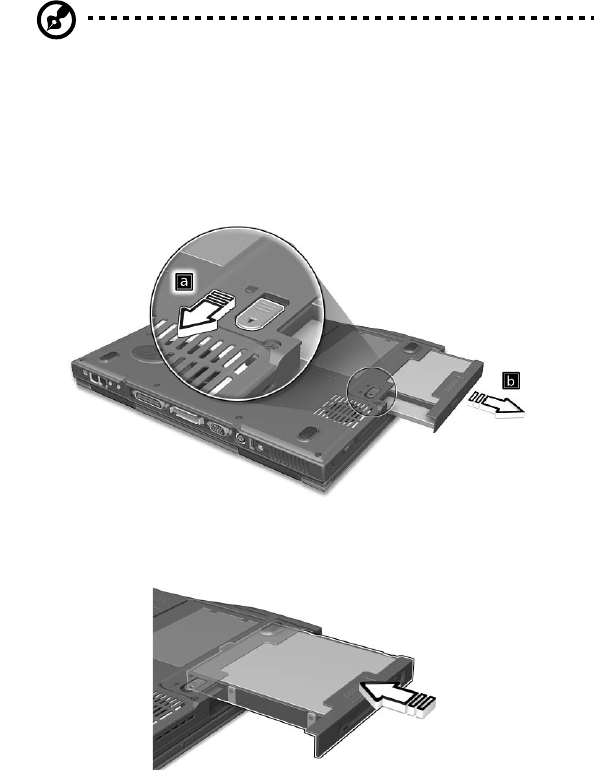
2 Customizing my computer52
Swapping AcerMedia drive modules
Note: The floppy and the hard disk drive modules are not hot-
swappable. You have to turn off your computer before you can
swap the modules.
You can swap the AcerMedia drive with any optional AcerMedia
modules. First slide the AcerMedia release latch as shown in the
illustration (a). Then remove the optical drive from the AcerMedia bay
(b).
Then insert the optional AcerMedia module into the AcerMedia bay
until the it click into place.
TM620-e.book Page 52 Tuesday, October 16, 2001 11:22 AM